-
 Bitcoin
Bitcoin $105,564.0464
0.23% -
 Ethereum
Ethereum $2,532.7861
-0.95% -
 Tether USDt
Tether USDt $1.0005
0.00% -
 XRP
XRP $2.1504
-0.10% -
 BNB
BNB $647.9477
-0.64% -
 Solana
Solana $145.7444
-0.88% -
 USDC
USDC $0.9999
0.01% -
 Dogecoin
Dogecoin $0.1778
-0.04% -
 TRON
TRON $0.2718
0.14% -
 Cardano
Cardano $0.6284
-1.25% -
 Hyperliquid
Hyperliquid $40.5452
-3.15% -
 Sui
Sui $2.9851
-1.60% -
 Chainlink
Chainlink $13.2472
-0.45% -
 Bitcoin Cash
Bitcoin Cash $437.5258
-1.68% -
 UNUS SED LEO
UNUS SED LEO $9.1153
0.92% -
 Stellar
Stellar $0.2577
-0.77% -
 Avalanche
Avalanche $18.9603
-1.59% -
 Toncoin
Toncoin $2.9625
-1.72% -
 Shiba Inu
Shiba Inu $0.0...01211
-0.08% -
 Litecoin
Litecoin $85.7512
-0.61% -
 Hedera
Hedera $0.1540
-2.92% -
 Polkadot
Polkadot $3.7877
-0.71% -
 Ethena USDe
Ethena USDe $1.0004
-0.01% -
 Monero
Monero $314.6226
1.31% -
 Dai
Dai $1.0000
0.00% -
 Bitget Token
Bitget Token $4.5216
-0.55% -
 Pepe
Pepe $0.0...01105
-1.09% -
 Uniswap
Uniswap $7.3637
-2.47% -
 Pi
Pi $0.6184
6.26% -
 Aave
Aave $275.1479
-4.78%
How to apply KDJ in wave theory? What are the characteristics of each wave shape?
KDJ indicator, derived from Stochastic Oscillator, helps traders spot buy/sell signals in crypto markets when combined with Elliott Wave Theory's wave patterns.
Jun 10, 2025 at 01:57 am
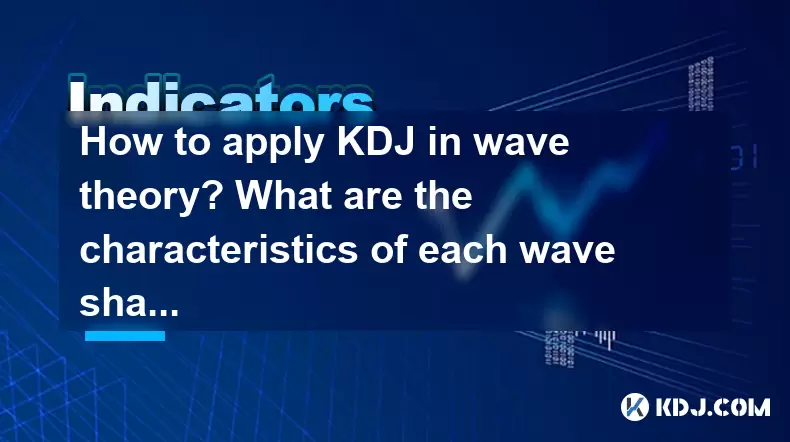
Introduction to KDJ and Wave Theory
The KDJ indicator is a popular technical analysis tool used by traders to identify potential buy and sell signals in the cryptocurrency market. It is an oscillator that measures momentum and is derived from the Stochastic Oscillator. The KDJ indicator consists of three lines: K, D, and J. The K line represents the fastest moving line, the D line is a slower moving average of the K line, and the J line is a more sensitive indicator that is calculated from the K and D lines.
Wave theory, also known as Elliott Wave Theory, is a method of technical analysis that traders use to identify recurring long-term price patterns and investor psychology in the cryptocurrency market. According to wave theory, market prices move in a series of five waves in the direction of the main trend, followed by three corrective waves. Understanding the characteristics of each wave shape can help traders predict future price movements.
Applying KDJ in Wave Theory
To effectively apply the KDJ indicator in wave theory, traders need to understand how to interpret the signals provided by the KDJ and correlate them with the wave patterns. Here’s a step-by-step guide on how to do this:
Identify the Current Wave: Start by identifying the current wave within the Elliott Wave pattern. This involves analyzing the price chart to determine if you are in a motive wave (1, 3, or 5) or a corrective wave (A, B, or C).
Monitor the KDJ Indicator: Once you have identified the current wave, monitor the KDJ indicator for potential buy or sell signals. A buy signal is typically generated when the K line crosses above the D line in the oversold area (below 20). Conversely, a sell signal is generated when the K line crosses below the D line in the overbought area (above 80).
Confirm with Wave Patterns: Use the KDJ signals to confirm the wave patterns. For instance, if you are in wave 3 (a strong upward wave), a buy signal from the KDJ can confirm the continuation of the upward trend. Similarly, if you are in wave A (a downward corrective wave), a sell signal can confirm the downward movement.
Adjust Trading Strategy: Based on the confirmed wave patterns and KDJ signals, adjust your trading strategy accordingly. This might involve entering a long position during a confirmed upward wave or a short position during a confirmed downward wave.
Characteristics of Motive Waves
Motive waves are the driving force behind the overall trend in the cryptocurrency market. They consist of five sub-waves and can be further categorized into three types: impulse waves, diagonal waves, and extensions.
Impulse Waves: These are the most common type of motive wave and are characterized by a clear five-wave structure. Wave 1 is the initial upward movement, wave 2 is a corrective wave that retraces part of wave 1, wave 3 is the strongest and longest upward wave, wave 4 is another corrective wave that retraces part of wave 3, and wave 5 is the final upward movement that often shows signs of exhaustion.
Diagonal Waves: These are less common and are characterized by a converging pattern. Diagonal waves can appear in the position of wave 1 or wave A and are typically followed by a sharp reversal.
Extensions: Extensions occur when one of the waves in the impulse sequence (usually wave 3) becomes disproportionately longer than the others. This can lead to significant price movements and requires traders to adjust their expectations and trading strategies accordingly.
Characteristics of Corrective Waves
Corrective waves are the counter-trend movements that follow the motive waves. They consist of three sub-waves and can be categorized into three main types: zigzags, flats, and triangles.
Zigzags: These are the most common type of corrective wave and are characterized by a sharp three-wave structure (A-B-C). Wave A is a downward movement, wave B is a corrective wave that retraces part of wave A, and wave C is the final downward movement that often exceeds the length of wave A.
Flats: Flats are characterized by a more sideways movement and are typically composed of three waves of similar length (A-B-C). Wave A and wave C are usually of similar magnitude, while wave B retraces a significant portion of wave A.
Triangles: Triangles are characterized by a converging pattern and are typically composed of five waves (A-B-C-D-E). They are usually found in the position of wave 4 or wave B and indicate a period of consolidation before the next major move.
Practical Application of KDJ and Wave Theory
To illustrate the practical application of KDJ and wave theory, let’s consider a hypothetical scenario in the cryptocurrency market:
Scenario: You are analyzing the price chart of Bitcoin and identify that it is currently in wave 3 of an impulse sequence. The KDJ indicator shows that the K line has crossed above the D line in the oversold area, generating a buy signal.
Action: Based on this information, you confirm that the upward trend in wave 3 is likely to continue. You decide to enter a long position on Bitcoin, setting your stop-loss just below the recent low to manage risk.
Monitoring: As the price continues to rise, you monitor the KDJ indicator for any signs of a potential reversal. If the K line crosses below the D line in the overbought area, it may indicate that wave 3 is nearing its end, prompting you to consider taking profits or adjusting your position.
Combining KDJ with Other Indicators
While the KDJ indicator can be a powerful tool when combined with wave theory, it is often beneficial to use additional indicators to confirm signals and improve the accuracy of your analysis. Some popular indicators that can be used in conjunction with KDJ and wave theory include:
Moving Averages: These can help identify the overall trend and provide additional confirmation of wave patterns. For instance, if the price is above the 50-day moving average during an upward wave, it can provide additional confidence in the bullish trend.
Relative Strength Index (RSI): The RSI is another momentum oscillator that can be used to confirm overbought or oversold conditions identified by the KDJ indicator. If both the KDJ and RSI indicate overbought conditions, it can provide a stronger signal for a potential reversal.
Fibonacci Retracement: This tool can help identify potential support and resistance levels within wave patterns. For instance, if the price retraces to a key Fibonacci level during a corrective wave, it can provide a potential entry point for a trade.
Frequently Asked Questions
Q1: Can the KDJ indicator be used effectively in all market conditions?
A1: The effectiveness of the KDJ indicator can vary depending on market conditions. In trending markets, the KDJ can be particularly useful for identifying potential entry and exit points. However, in ranging or choppy markets, the KDJ may generate false signals, requiring traders to use additional indicators for confirmation.
Q2: How can traders differentiate between impulse waves and corrective waves?
A2: Traders can differentiate between impulse waves and corrective waves by analyzing the structure and direction of the waves. Impulse waves typically consist of five sub-waves in the direction of the main trend, while corrective waves consist of three sub-waves against the main trend. Additionally, impulse waves often exhibit stronger momentum and clearer price movements compared to corrective waves.
Q3: What are the limitations of using the KDJ indicator in wave theory?
A3: One of the main limitations of using the KDJ indicator in wave theory is the potential for false signals, especially in volatile or choppy markets. Additionally, the KDJ is a lagging indicator, meaning it may not always provide timely signals for entering or exiting trades. Traders should use the KDJ in conjunction with other indicators and analysis tools to improve the accuracy of their trading decisions.
Q4: How can traders manage risk when using the KDJ and wave theory?
A4: Risk management is crucial when using the KDJ and wave theory. Traders can manage risk by setting stop-loss orders to limit potential losses, using position sizing to control the amount of capital at risk, and diversifying their trading portfolio to spread risk across different assets. Additionally, traders should continuously monitor market conditions and adjust their strategies as needed to adapt to changing trends and signals.
Disclaimer:info@kdj.com
The information provided is not trading advice. kdj.com does not assume any responsibility for any investments made based on the information provided in this article. Cryptocurrencies are highly volatile and it is highly recommended that you invest with caution after thorough research!
If you believe that the content used on this website infringes your copyright, please contact us immediately (info@kdj.com) and we will delete it promptly.
- PayPal's PYUSD Stablecoin Investigated by the SEC, But No Enforcement Action Is Being Sought
- 2025-06-15 11:25:12
- Turbo (TURBO) Price Prediction 2025-2030: Can Turbo Rocket Upwards Once Again and Deliver a New All-Time High?
- 2025-06-15 11:25:12
- Eric Trump Says Banks Will Need to Utilize Blockchain Technology if They Want to Survive the Next Decade
- 2025-06-15 11:20:12
- Cardano [ADA] Surpasses Ethereum [ETH] in Developer Activity, Signaling a Potential Shift in the Competitive Landscape of Blockchain Platforms.
- 2025-06-15 11:20:12
- The Intersection of Artificial Intelligence and Crypto Is Heating Up, and May 2025 Is Shaping Up to Be a Pivotal Month for Some of the Sector's Most Promising Tokens
- 2025-06-15 11:15:11
- Bybit Launches 1V1 Trading Arena, Gamifying Trading Experience for Crypto Pros and Beginners
- 2025-06-15 11:15:11
Related knowledge
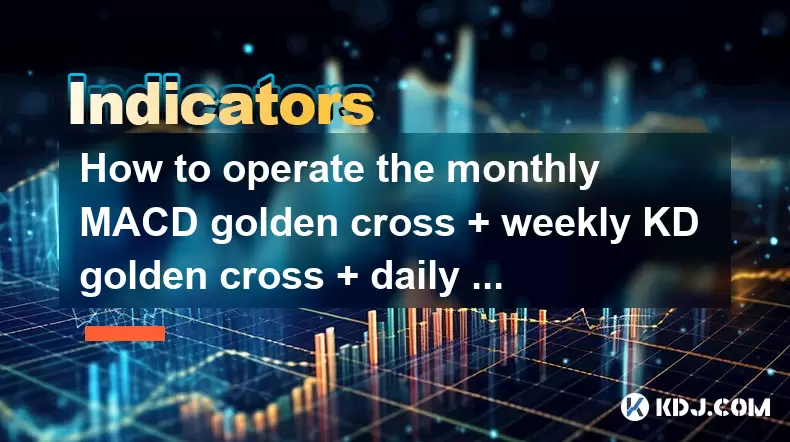
How to operate the monthly MACD golden cross + weekly KD golden cross + daily volume breakthrough?
Jun 15,2025 at 05:36am
Understanding the Strategy: Monthly MACD Golden CrossTo effectively operate the monthly MACD golden cross, traders must first understand what this signal entails. The MACD (Moving Average Convergence Divergence) golden cross occurs when the MACD line crosses above the signal line on a given chart timeframe. When this happens on the monthly chart, it sug...
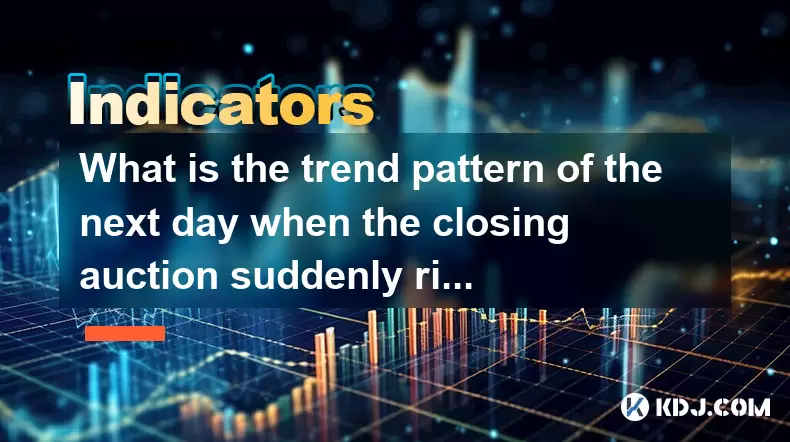
What is the trend pattern of the next day when the closing auction suddenly rises?
Jun 15,2025 at 08:15am
Understanding Closing Auctions in Cryptocurrency MarketsIn the context of cryptocurrency trading, a closing auction refers to a mechanism used by exchanges to determine the closing price of an asset at the end of a trading session. This process typically occurs within a short time window before the market closes for the day and aims to provide a fair an...

What does it mean when the volume fluctuates during the sideways trading at high levels?
Jun 15,2025 at 10:28am
Understanding Volume Fluctuations in Sideways TradingWhen volume fluctuates during sideways trading at high levels, it refers to the changes in the number of assets traded over a given period while the price remains relatively stable, moving within a defined range. This phenomenon typically occurs when the market lacks a clear directional bias—neither b...
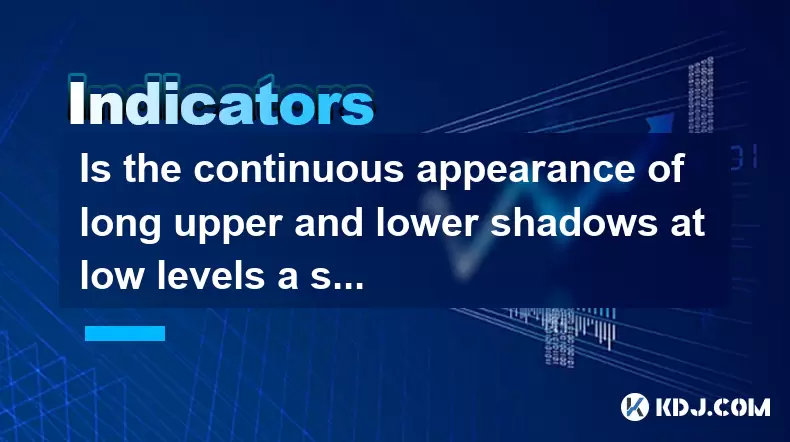
Is the continuous appearance of long upper and lower shadows at low levels a signal of accumulation?
Jun 15,2025 at 01:43am
Understanding Long Upper and Lower Shadows in Candlestick ChartsIn the world of cryptocurrency trading, candlestick patterns are widely used to analyze price movements. A long upper shadow, also known as a wick or tail, indicates that the price rose significantly during the period but was pushed back down by selling pressure. Conversely, a long lower sh...
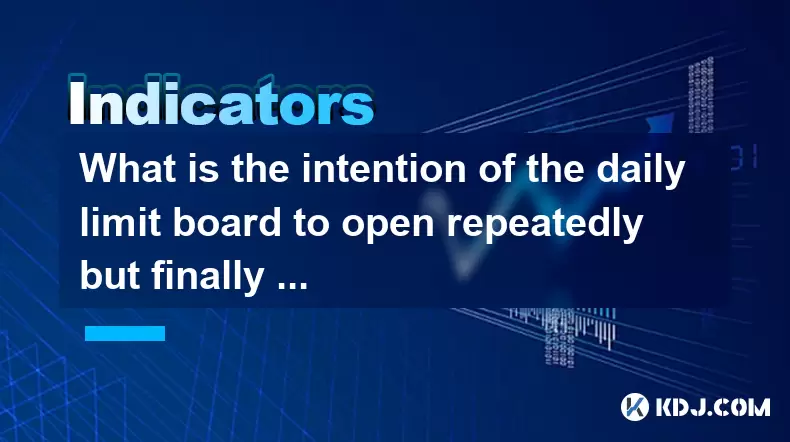
What is the intention of the daily limit board to open repeatedly but finally close?
Jun 15,2025 at 01:08am
Understanding the Daily Limit Board in Cryptocurrency TradingIn cryptocurrency trading, a daily limit board refers to a price movement restriction mechanism applied by certain exchanges or regulatory bodies. This mechanism is primarily used to prevent extreme volatility and panic selling or buying during periods of intense market fluctuation. When an as...

How to calculate the probability of trend continuation after the MACD column divergence?
Jun 14,2025 at 08:01am
Understanding MACD Column DivergenceThe Moving Average Convergence Divergence (MACD) is a widely used technical indicator in cryptocurrency trading. The MACD column, also known as the histogram, represents the difference between the MACD line and the signal line. When price makes a new high or low but the MACD histogram does not confirm this movement, a...

How to operate the monthly MACD golden cross + weekly KD golden cross + daily volume breakthrough?
Jun 15,2025 at 05:36am
Understanding the Strategy: Monthly MACD Golden CrossTo effectively operate the monthly MACD golden cross, traders must first understand what this signal entails. The MACD (Moving Average Convergence Divergence) golden cross occurs when the MACD line crosses above the signal line on a given chart timeframe. When this happens on the monthly chart, it sug...

What is the trend pattern of the next day when the closing auction suddenly rises?
Jun 15,2025 at 08:15am
Understanding Closing Auctions in Cryptocurrency MarketsIn the context of cryptocurrency trading, a closing auction refers to a mechanism used by exchanges to determine the closing price of an asset at the end of a trading session. This process typically occurs within a short time window before the market closes for the day and aims to provide a fair an...

What does it mean when the volume fluctuates during the sideways trading at high levels?
Jun 15,2025 at 10:28am
Understanding Volume Fluctuations in Sideways TradingWhen volume fluctuates during sideways trading at high levels, it refers to the changes in the number of assets traded over a given period while the price remains relatively stable, moving within a defined range. This phenomenon typically occurs when the market lacks a clear directional bias—neither b...

Is the continuous appearance of long upper and lower shadows at low levels a signal of accumulation?
Jun 15,2025 at 01:43am
Understanding Long Upper and Lower Shadows in Candlestick ChartsIn the world of cryptocurrency trading, candlestick patterns are widely used to analyze price movements. A long upper shadow, also known as a wick or tail, indicates that the price rose significantly during the period but was pushed back down by selling pressure. Conversely, a long lower sh...

What is the intention of the daily limit board to open repeatedly but finally close?
Jun 15,2025 at 01:08am
Understanding the Daily Limit Board in Cryptocurrency TradingIn cryptocurrency trading, a daily limit board refers to a price movement restriction mechanism applied by certain exchanges or regulatory bodies. This mechanism is primarily used to prevent extreme volatility and panic selling or buying during periods of intense market fluctuation. When an as...

How to calculate the probability of trend continuation after the MACD column divergence?
Jun 14,2025 at 08:01am
Understanding MACD Column DivergenceThe Moving Average Convergence Divergence (MACD) is a widely used technical indicator in cryptocurrency trading. The MACD column, also known as the histogram, represents the difference between the MACD line and the signal line. When price makes a new high or low but the MACD histogram does not confirm this movement, a...
See all articles

























































































